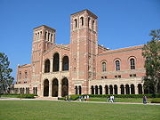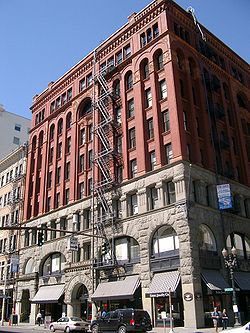
Romanesque Revival architecture
Encyclopedia

Architectural style
Architectural styles classify architecture in terms of the use of form, techniques, materials, time period, region and other stylistic influences. It overlaps with, and emerges from the study of the evolution and history of architecture...
of building employed beginning in the mid 19th century inspired by the 11th and 12th century Romanesque architecture
Romanesque architecture
Romanesque architecture is an architectural style of Medieval Europe characterised by semi-circular arches. There is no consensus for the beginning date of the Romanesque architecture, with proposals ranging from the 6th to the 10th century. It developed in the 12th century into the Gothic style,...
. Unlike the historic Romanesque style, however, Romanesque Revival buildings tended to feature more simplified arches and windows than their historic counterparts.
An early variety of Romanesque revival style known as Rundbogenstil
Rundbogenstil
Rundbogenstil , one of the nineteenth-century historic revival styles of architecture, is a variety of Romanesque revival popular in the German-speaking lands and the German diaspora....
("Round-arched style") was popular in German lands and in the German diaspora beginning in the 1830s. By far the most prominent and influential American architect working in a free "Romanesque" manner was Henry Hobson Richardson
Henry Hobson Richardson
Henry Hobson Richardson was a prominent American architect who designed buildings in Albany, Boston, Buffalo, Chicago, Pittsburgh, and other cities. The style he popularized is named for him: Richardsonian Romanesque...
. In the United States, the style derived from examples set by him are termed Richardsonian Romanesque
Richardsonian Romanesque
Richardsonian Romanesque is a style of Romanesque Revival architecture named after architect Henry Hobson Richardson, whose masterpiece is Trinity Church, Boston , designated a National Historic Landmark...
, of which not all are Romanesque revival.
Characteristics
Popular features of these revival buildings are round archArch
An arch is a structure that spans a space and supports a load. Arches appeared as early as the 2nd millennium BC in Mesopotamian brick architecture and their systematic use started with the Ancient Romans who were the first to apply the technique to a wide range of structures.-Technical aspects:The...
es, semi-circular arches on windows, and belt course
Belt course
A belt course is a continuous row or layer of stones, tile, brick, shingles, etc. in a wall. The Romanesque style of architecture is notable for the use of belt courses. Similar to a belt course is an entablature which runs along the top of a row columns instead of along a wall....
s.
Like its influencing Romanesque style, the Romanesque Revival Style was widely used for churches, and occasionally for synagogues such as the Congregation Emanu-El of New York on Fifth Avenue built in 1929. During the 19th century the architecture selected for Anglican churches depended on the churchmanship of particular congregations. Whereas high churches and Anglo-Catholic, which were influenced by the Oxford Movement
Oxford Movement
The Oxford Movement was a movement of High Church Anglicans, eventually developing into Anglo-Catholicism. The movement, whose members were often associated with the University of Oxford, argued for the reinstatement of lost Christian traditions of faith and their inclusion into Anglican liturgy...
, were built in Gothic Revival architecture
Gothic Revival architecture
The Gothic Revival is an architectural movement that began in the 1740s in England...
, low churches and broad churches of the period were often built in the Romanesque Revival style.
The style was quite popular for university campuses in the late nineteenth and early twentieth century, especially in the United States and Canada; well known examples can be found at the University of California, Los Angeles
University of California, Los Angeles
The University of California, Los Angeles is a public research university located in the Westwood neighborhood of Los Angeles, California, USA. It was founded in 1919 as the "Southern Branch" of the University of California and is the second oldest of the ten campuses...
, University of Southern California
University of Southern California
The University of Southern California is a private, not-for-profit, nonsectarian, research university located in Los Angeles, California, United States. USC was founded in 1880, making it California's oldest private research university...
, University of Denver
University of Denver
The University of Denver is currently ranked 82nd among all public and private "National Universities" by U.S. News & World Report in the 2012 rankings....
, and the University of Toronto
University of Toronto
The University of Toronto is a public research university in Toronto, Ontario, Canada, situated on the grounds that surround Queen's Park. It was founded by royal charter in 1827 as King's College, the first institution of higher learning in Upper Canada...
.
Examples in Canada
University College, one of seven colleges at the University of TorontoUniversity of Toronto
The University of Toronto is a public research university in Toronto, Ontario, Canada, situated on the grounds that surround Queen's Park. It was founded by royal charter in 1827 as King's College, the first institution of higher learning in Upper Canada...
, is a chief example of the Romanesque Revival Style. The building, designed by Frederic Cumberland and William G. Storm, was initially intended to be Gothic in style but was rejected by the governor general. Construction of the final design began on 4 October 1856. The facade of University College has thick masonry walls, incorporating layers of both stone and brick. The building possesses a number of round arches characteristic of the Roman Revival Style. The arches are configured in arcades, most notably on the south side of the building. There is a great deal of ornamentation on both the interior and exterior of University College. The main doors of the building are prominent examples of the heavy ornamentation used by Cumberland and Storm. The entrance is elaborate in its decoration with columns on either side of the doors and intricate patterns carved into stone. The rugged Romanesque Revival building was declared a National Historic Site of Canada in 1968.
A prime example of the Romanesque Revival Style is the Old City Hall
Old City Hall (Toronto)
Toronto's Old City Hall was home to its city council from 1899 to 1966 and remains one of the city's most prominent structures. The building is located at the corner of Queen and Bay Streets, across Bay Street from Nathan Phillips Square and the new City Hall in the centre of downtown Toronto...
built in Toronto from 1889 to 18 September 1899, designed by Edward James Lennox. Its exterior walls built with intricate detail such as the caricatures of politicians are carved above the columns at the entrance and even the doorknobs have the city’s old coat of arms on them. A very noticeable feature is the clock tower standing 103.6 meters high, one of the most prominent parts of this tower is how there are four gargoyles placed on the four corners of the tower. The gargoyles originally were made from limestone but they were replaced by bronze sculptures after a part of the stone gargoyle broke off and fell into the attic below in 1938. The simple yet elaborate arches over the entrances, the corner pavilions and the intricate designs on the walls and entrances are all examples of some of the different elements of the Romanesque Revival Style that are commonly used. Another indication of the Romanesque Revival Style is the usage of the square shape in the design and the how it almost seems caste-like especially just with the fact of how extremely large and tall everything is, giving it a grand-like feeling. The use of the different sandstones along with the change of colors between red and brown create an interesting contrast and gives the entire building a very ‘rugged’ look.
See also
- Richardsonian RomanesqueRichardsonian RomanesqueRichardsonian Romanesque is a style of Romanesque Revival architecture named after architect Henry Hobson Richardson, whose masterpiece is Trinity Church, Boston , designated a National Historic Landmark...
- RundbogenstilRundbogenstilRundbogenstil , one of the nineteenth-century historic revival styles of architecture, is a variety of Romanesque revival popular in the German-speaking lands and the German diaspora....
- Gothic Revival architectureGothic Revival architectureThe Gothic Revival is an architectural movement that began in the 1740s in England...
- Museum of Early Trades and CraftsMuseum of Early Trades and CraftsThe Museum of Early Trades and Crafts is a non-profit educational institution in Madison, New Jersey. The museum's mission is:The museum's historic structure, the Madison Public Library and the James Building, is listed on the National Register of Historic Places .-History:The museum was founded in...

